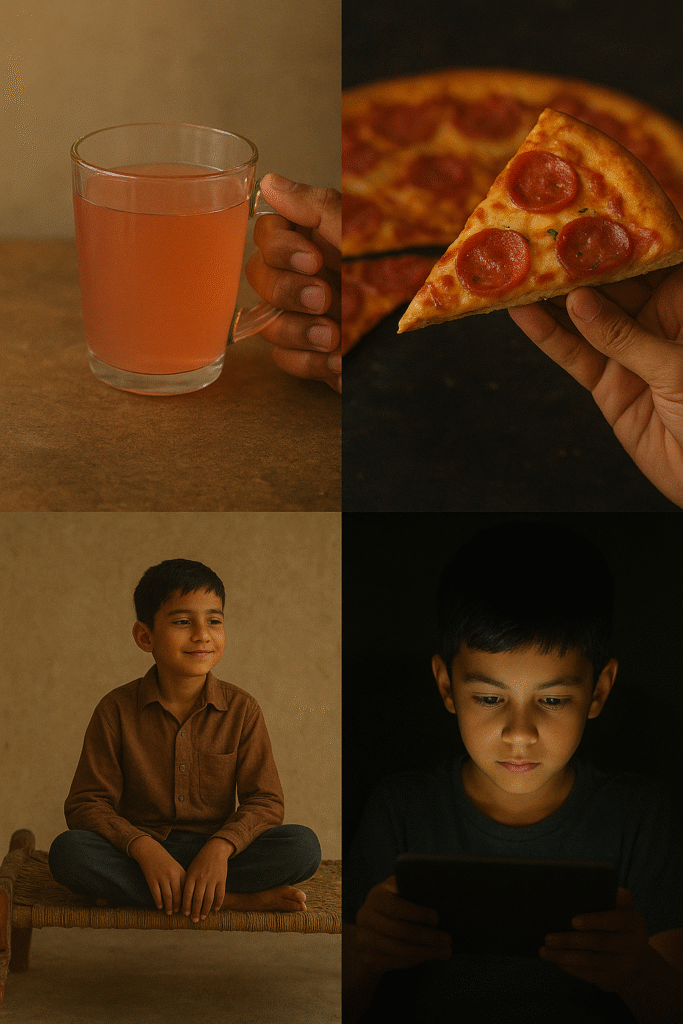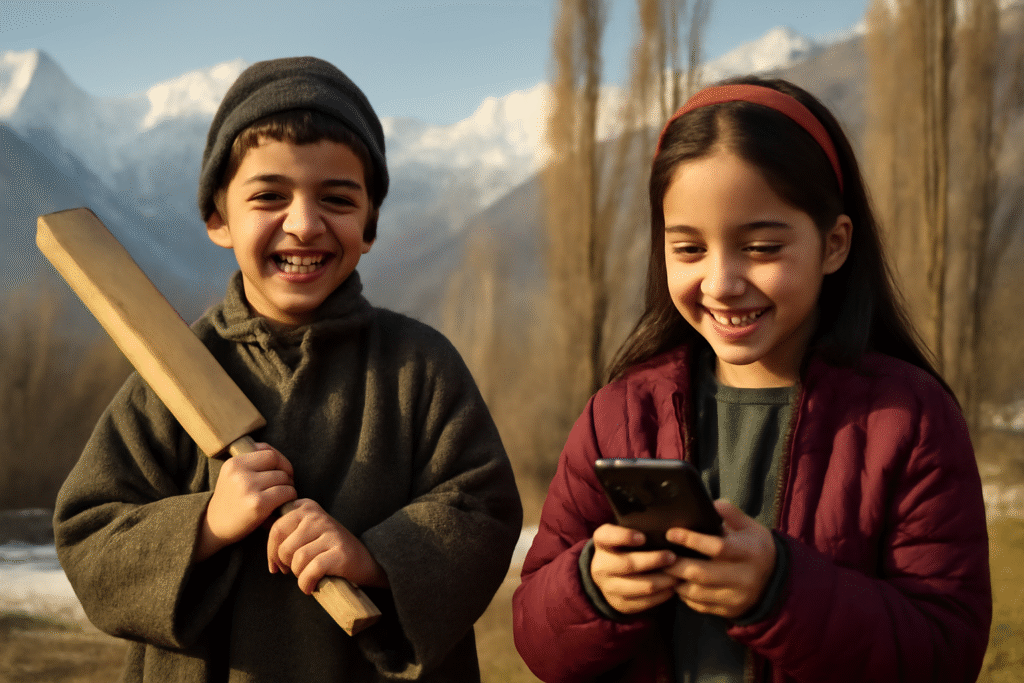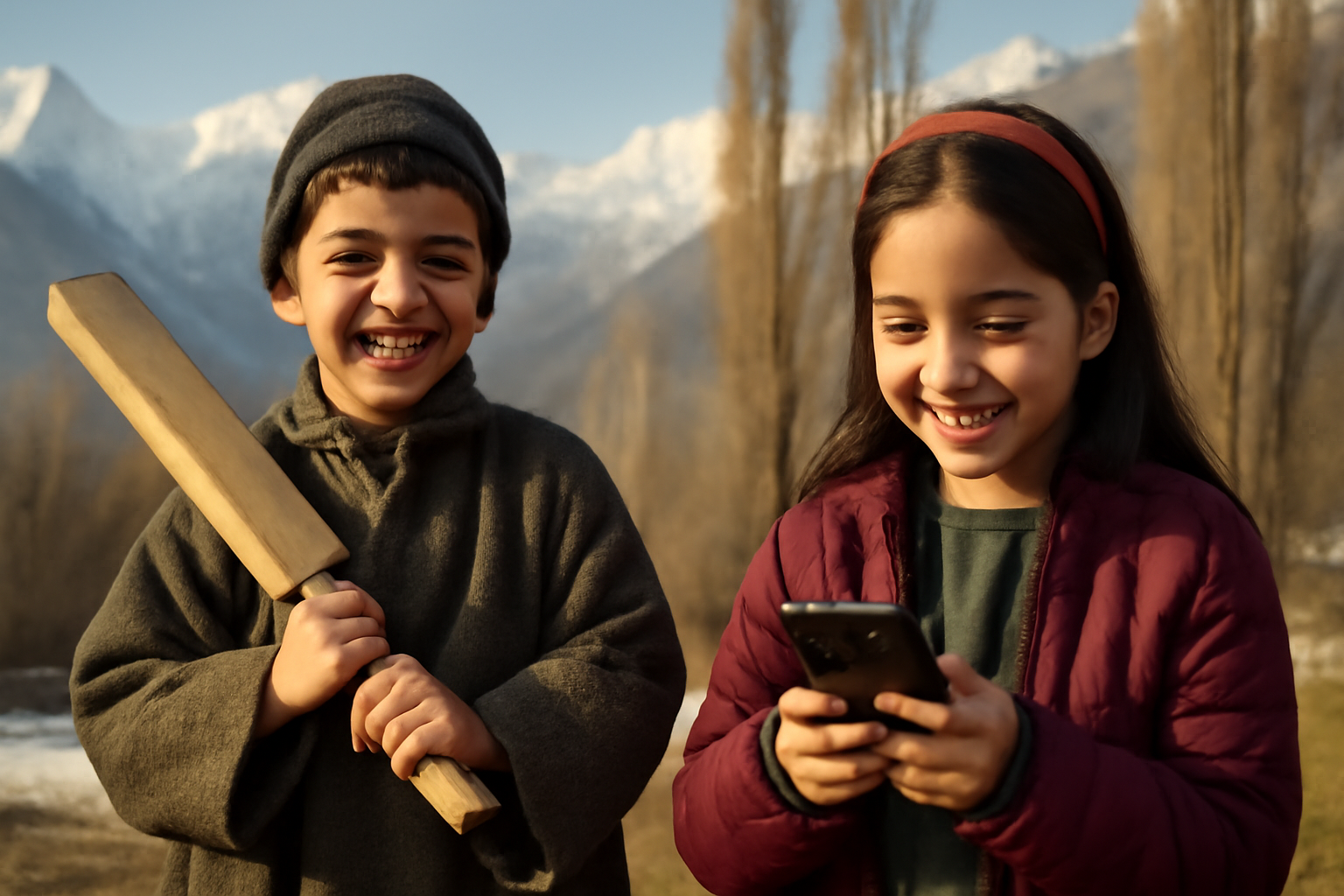By Rayees Ahmad Kumar
Childhood has always been the most delicate and crucial stage of human life. Doctors advise parents to exercise extra caution during these formative years, while psychologists and educationists stress the need for vigilance, knowing that this stage becomes the cornerstone of a person’s overall personality. Writers and poets have celebrated childhood in verses and prose, capturing its innocence, aspirations, and unfiltered joy—an innocence rarely preserved into adulthood.

But the essence of childhood, especially in Kashmir, has undergone a dramatic transformation over the past few decades. To compare the childhood of three or four decades ago with that of today is to look at two different worlds—both shaped by their times, yet standing apart in values, habits, and experiences.
In the Kashmir of the past, before mobile phones and handheld screens, children lived in rhythm with the seasons and the pulse of their homes. Mornings would begin with a cup of pink salt tea brewed by mothers on traditional clay chulas. A freshly baked bread made from rice or wheat flour, turned golden on an iron pan, was enough to satisfy early hunger. After this simple breakfast, children prepared their school lessons—writing neatly on both sides of a wooden takhti, often practicing English and Urdu lines. Mothers would soon call them for rice before they set out for school.
At school, camaraderie flourished. Children shared lunchboxes, exchanged ideas, and supported each other in learning. Recess was not just about food but about strengthening friendships. Mid-day meals in schools were unheard of then, so many children would return home at noon for a quick bite before resuming classes. The end of the school day meant one thing: play.
By late afternoon, neighborhood playgrounds filled with the sounds of cricket bats striking balls, volleyballs soaring in the air, and the rhythmic claps of kabaddi matches. Childhood was lived outdoors, in the dust, in the snow, under the walnut trees, and by the frozen streams. Winters brought the joy of snowball fights and the thrill of sliding down icy slopes. Autumn carried its own rituals—children waking up at dawn to collect walnuts shaken loose overnight. Evenings often ended with the comforting warmth of family storytelling. Grandparents spun tales that lit up young imaginations, sometimes accompanied by a steaming cup of kehwa or a bowl of suji or gajar ka halwa, lovingly prepared by mothers. Childhood, in those times, was woven with simplicity, discipline, and collective joy.
Today, that landscape looks starkly different. Technology has infiltrated every corner of childhood. The once-cherished playground lies abandoned as smartphones, laptops, and video games monopolize young attention. The modern child spends more time swiping screens than flipping book pages. Study hours shrink, replaced by the lure of social media and endless online distractions. Parents struggle to wean their children off screens just long enough to focus on schoolwork.
The morning routines, too, have changed. Traditional pink tea and home-cooked rice meals give way to packaged snacks and junk food bought from roadside stalls. Instead of the wholesome nourishment of home kitchens, fast food dominates young diets. Social interaction, once built around shared meals and classroom bonds, now thrives in the digital realm, with “friends” measured not by trust or presence but by numbers on Instagram and Facebook.
Book reading, once regarded as a sacred hobby, is in sharp decline. A child who once found joy in stories read aloud or carefully copied from textbooks now dismisses books as boring. In their place come short-form videos, reels, and memes—snippets of entertainment that demand little thought and offer fleeting satisfaction.
The moral fabric of childhood, too, appears frayed. Where once ethical lessons were passed naturally from parents, teachers, and elders, today’s children often resist such guidance, quick to argue and quicker still to dismiss. Instead of emulating real-life role models, they pursue digital idols, chasing likes and followers. Many dream not of careers built on education or skills but of instant fame as YouTubers, TikTok performers, or influencers.

Technology, which could have been a tool of empowerment, has often become a trap. Instead of harnessing its potential for learning and creativity, many children use it recklessly, isolating themselves from family bonds and real-world challenges. They idolize fabricated online personas while drifting away from their own cultural and familial roots. Festivals and traditions, once the heartbeat of family gatherings and communal joy, hold little value in this digital-first childhood.
This transformation is not without consequence. Childhood in Kashmir today risks becoming mechanical, where emotions are dulled and imagination replaced by algorithms. The danger is not only in wasted hours but in the erosion of values, ethics, and human connection.
Yet, hope lies in conscious intervention. If parents, educators, and communities choose to reclaim the legacy of Kashmir’s rich traditions, a balance can be struck. The goal is not to reject technology but to teach judicious use—encouraging children to value books alongside devices, outdoor games alongside online ones, and human bonds above digital illusions.
Childhood should remain vibrant, colorful, and full of innocence. To ensure that, society must hold firmly to the rope of its cultural heritage, passing down ethics, stories, and values to the next generation. Only then can children grow into civilized, compassionate citizens capable of navigating both the beauty of tradition and the promise of modernity.
The paradise that is Kashmir deserves nothing less than children who mirror its purity and resilience. And childhood, that delicate yet defining stage, must be nurtured with care—not lost to screens, but shaped by stories, love, and the timeless lessons of human connection.
The views expressed in this article are solely those of the author and do not necessarily reflect the opinions or views of this newspaper
